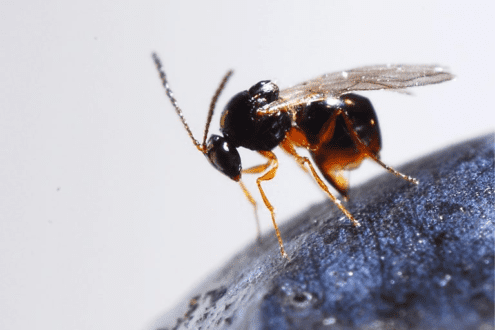

Aug 5, 2022Tiny wasps could add to anti-SWD pest defense plans
Collaborating researchers recently released tiny wasps in selected West Coast locations hoping they’ll establish and help control the spotted-wing drosophila fruit fly (SWD).
Vaughn Walton, an Oregon State University entomologist, said he doesn’t expect the wasp – known scientifically as Ganaspis brasiliensis – to be a silver bullet for SWD control. Instead, he views it as complementing growers’ existing management programs.
“We know the majority of the SWD population is not in the crop. It’s in the surrounding region,” Walton said. “That’s why we’re releasing these parasitoids in the surrounding regions in hopes that the (SWD) populations are brought down. Maybe we can save two to three pesticide sprays per season.”
With growers spending about $100 per insecticide application per acre, not to mention incurring losses from fruit damage, he said the wasp may offer significant savings while reducing environmental impacts.
Stuart Olson, who grows stone fruit, blueberries and cane berries near Salem, Oregon, had the first farm in the state where SWD was confirmed in 2009. Since then, he said spraying for the pest has disrupted his integrated pest management program “big time.”
“We had a great IPM program here,” he said of past efforts to rely on beneficial insects to help keep pests in check.
But Olson said he remains hopeful that parasitoids, such as Ganaspis, will help manage SWD.
“People like Vaughn, they’re going to find a little critter that maybe will keep this thing at bay,” he said.
T.J. Hafner, agronomy manager for AgriCare farm management in Jefferson, Oregon, described SWD as one of the most significant challenges faced in organic blueberry production.
“It’s probably the most costly pest we deal with in blueberries because of the amount of sprays we have to do,” he said.
Nevertheless, Hafner said he’s optimistic about potential SWD biological control. He pointed to the successful introduction of another small wasp that has provided widespread filbert and hazelnut aphid control.
“I think this is certainly a step in the right direction for organic farming, in particular,” he said about the SWD parasitoid. “Anything helps.”
Even before the releases, Washington State University and Washington State Department of Agriculture entomologists found the parasitoid in Whatcom County, Washington, in 2020 and 2021. A Canadian team found the minute wasp in that country in 2019.
“I can’t tell you how thrilled we were to find this in Washington state last year – it was like we hit gold,” said Betsy Beers, a WSU entomology professor.
How G. brasiliensis got there remains a mystery.
“Just like pests have the habit of moving around, so do their parasitoids,” she said. “The same way SWD got into the country, so might their parasitoid.”
Currently, members of her lab are surveying Whatcom County to determine how widespread the parasitoid is.
Searching SWD’s native range
Native to Asia, Drosophila suzukii – as SWD is known – was first confirmed in the U.S. in California in 2008. Since then, it has become established in most U.S. fruit-growing regions. SWD attacks thin-skinned, soft fruit, including cherries, stone fruit, grapes, cane berries, strawberries and blueberries as well as other wild species.
The pest damages fruit in two ways. Female SWD insert sharp ovipositors to lay eggs in fruit just beginning to ripen, creating openings for other pests. Once the eggs hatch, larvae feed on the flesh, rendering fruit unmarketable.
Betsey Miller, an OSU research assistant, participated in two expeditions to South Korea in 2012 to search for potential biological control agents in SWD’s native range. Four or five candidates were collected and sent to Kent Daane, University of California Cooperative Extension entomologist, to determine their host range.
After conducting extensive laboratory tests in quarantine, he found G. brasiliensis was the most host-specific parasitoid and only attacked SWD.
“You don’t want to run into a scenario where you’re releasing something that will cause damage,” Walton said. “You want something that’s very specific – this is why this parasitoid was selected.”
In addition, the USDA’s Animal and Plant Health Inspection Service had to approve G. brasiliensis releases, which it did in 2021.
A sci-fi movie scene
The wasp, about 1/12-inch long, is referred to as a parasitoid because its immature stage develops within another insect. In this case, female wasps lay eggs in SWD larvae or pupae. Developing wasp larvae feed on the immature flies from the inside, eventually killing them and emerging as adult wasps.
Researchers have set a goal of releasing about 1,000 wasps this year in West Coast locations mostly around historically SWD- infested fields.
Even without crops during the winter, native vegetation in adjacent areas should provide alternate hosts on which SWD can feed. In turn, the SWD will provide targets in which G. brasiliensis can reproduce. The researchers plan to return in spring 2023 to gauge wasp reproduction and SWD parasitism.
“Of 100 SWD, only five are in the field itself,” Vaughn said. “The majority are in the surrounding area, and it’s those 95 that will be knocked down. It’s more preventive – you’re taking out a big chunk of the population in that surrounding vegetation before that crop in the field even ripens.”
Funding the parasitoid releases in California, Oregon and Washington is a USDA Area-wide SWD research grant. An overlapping multi-year multi-state USDA Specialty Crop Research Initiative grant is underwriting research into sustainable SWD management nationally, including beneficial insect releases. Beers and Walton are involved with both efforts.
– Vicky Boyd, contributing writer














